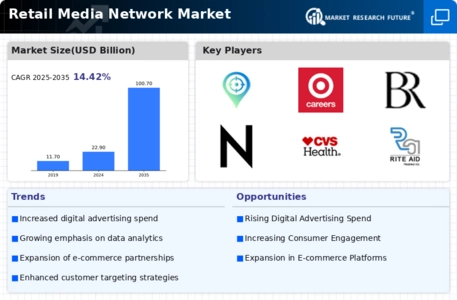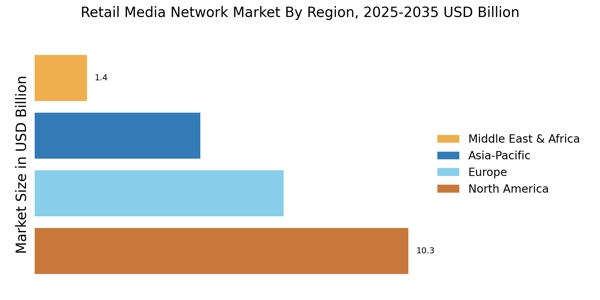Rise of Omnichannel Retailing
The Retail Media Network Market is significantly influenced by the rise of omnichannel retailing. As consumers increasingly engage with brands across multiple channels, retailers are compelled to create cohesive shopping experiences that integrate online and offline touchpoints. This trend is reflected in the fact that over 70% of consumers now expect a seamless transition between channels. Retail media networks play a crucial role in this landscape by providing advertising solutions that can be deployed across various platforms, ensuring consistent messaging and engagement. As retailers continue to embrace omnichannel strategies, the Retail Media Network Market is likely to expand, offering brands innovative ways to connect with consumers throughout their shopping journeys.
Expansion of E-commerce Platforms
The Retail Media Network Market is benefiting from the rapid expansion of e-commerce platforms. As more consumers turn to online shopping, retailers are increasingly investing in their digital infrastructures to capture this growing market. In 2025, e-commerce sales are expected to surpass 6 trillion dollars, creating a fertile ground for retail media networks to thrive. These networks enable retailers to monetize their online spaces by offering advertising opportunities to brands looking to reach engaged consumers. The integration of retail media networks into e-commerce platforms allows for seamless advertising experiences, enhancing the overall shopping journey. This trend suggests that the Retail Media Network Market will continue to grow as e-commerce becomes an integral part of consumer behavior.
Adoption of Advanced Analytics and AI
The Retail Media Network Market is witnessing a significant shift towards the adoption of advanced analytics and artificial intelligence. Retailers are increasingly leveraging these technologies to optimize their advertising strategies and improve campaign performance. By utilizing data-driven insights, brands can better understand consumer behavior and preferences, leading to more effective targeting and engagement. In 2025, it is anticipated that the use of AI in advertising will increase by over 40%, indicating a strong trend towards data-centric approaches in the Retail Media Network Market. This technological advancement not only enhances the efficiency of advertising campaigns but also allows for real-time adjustments, ensuring that brands can respond swiftly to changing consumer dynamics.
Increased Investment in Digital Advertising
The Retail Media Network Market is experiencing a notable surge in investment as brands recognize the value of digital advertising. In 2025, it is estimated that digital ad spending will reach approximately 500 billion dollars, reflecting a shift from traditional media to more targeted online platforms. This trend is driven by the need for brands to engage consumers where they spend most of their time—online. Retail media networks provide a unique opportunity for brands to leverage first-party data, allowing for more personalized and effective advertising strategies. As retailers enhance their digital capabilities, the Retail Media Network Market is likely to see continued growth, with more brands allocating budgets towards these networks to maximize their reach and impact.
Consumer Demand for Personalized Experiences
The Retail Media Network Market is increasingly shaped by consumer demand for personalized shopping experiences. As consumers become more discerning, they expect brands to deliver tailored content and recommendations that resonate with their individual preferences. This demand is reflected in the growing use of data analytics and artificial intelligence by retailers to create customized advertising strategies. In 2025, it is projected that personalized advertising will account for over 30% of total digital ad spending. Retail media networks are well-positioned to meet this demand, as they can utilize rich consumer data to enhance targeting and engagement. Consequently, the Retail Media Network Market is likely to expand as brands strive to fulfill consumer expectations for personalization.


















Leave a Comment